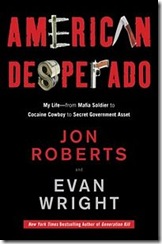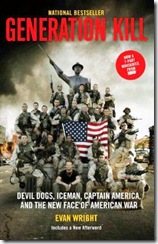Even though he uncovered the story, journalist Evan Wright never expected to write a full account of the drug cartel hit man from Miami who ― allegedly, as they say ― became a top CIA officer and a leading figure in the clandestine war against terror.
On the contrary, Wright thought this story, which resembles The Departed, but on a bigger, more important stage, would be picked up and developed by other journalists after the publication of his latest book, American Desperado.
An as-told-to autobiography of the infamous cocaine cowboy Jon Roberts, American Desperado includes a vivid anecdote about Enrique Prado, the hit man-turned-CIA honcho. In 1977, according to Roberts, Prado was the triggerman in the murder of Meyer Lansky’s stepson, Richard Schwartz, in Miami Beach.
“I sort of thought the Prado stuff would have been picked up by another reporter,” says Wright from his home in Los Angeles. “I’d worked on [the Roberts book] for three years. I didn’t want to do anything else with it.”
But American Desperado made less of a splash than Wright’s publisher expected – inexplicably, because it may be the best book of its kind since Nicholas Pileggi’s Wise Guys. No one picked up the thread of the potentially explosive Prado story.
Why has the story of a gangster-turned-top spy, protected from police investigations by the CIA, been ignored? “The answer is in the question,” Wright says. “When you say ‘CIA hit man,’ a lot of people think you are a raving conspiracy nut.”
So Wright, who is perhaps best known as the author of Generation Kill, developed the story himself. His investigation into the life and career of Enrique “Ricky” Prado appeared recently as How to Get Away with Murder in America, at Byliner Originals, the online site devoted to long-form journalism.
“We feel as journalists that this is the kind of story we live for,” says Mark Bryant, Byliner’s co-founder and editor-in-chief. “Evan is an exceptional journalist and an excellent writer, and he’s been burrowing into this story for a long time. His sources are sound. It’s an important story to tell.”
 When Roberts told Wright in 2008 that he had taken part in an “infamous” 1977 hit with a man who later become a top CIA officer, the journalist was skeptical. According to Roberts, Prado was an enforcer for Alberto San Pedro, a powerful, politically connected and violent Miami cocaine kingpin.
When Roberts told Wright in 2008 that he had taken part in an “infamous” 1977 hit with a man who later become a top CIA officer, the journalist was skeptical. According to Roberts, Prado was an enforcer for Alberto San Pedro, a powerful, politically connected and violent Miami cocaine kingpin.
But as Wright fact-checked Roberts’ account of his life, he found virtually all the most outlandish stories were true. Shortly after hearing Roberts’ story about Prado, for example, Wright learned that a high-ranking CIA officer named Enrique Prado did exist. Entering the agency in 1982, Prado took part in the CIA’s work in Central America, served as station chief in South Korea, helped devise and coordinate counterterrorism efforts following 9-11, and ran a “targeted assassination unit” – first at the agency, then at Blackwater, where he served as vice president from 2004 to 2008.
Perhaps the single most unbelievable thing, assuming the CIA’s “Ricky Prado” is the same person Roberts knew, is the idea that Prado continued to work for San Pedro even after he joined the agency.
Early on, when he began to uncover documents about Prado’s criminal past, Wright decided the story was separate from the Roberts book. Chief among these: “[L]ong-suppressed files from a 1991 federal RICO and murder investigation” by an organized crime task force.
“Jon ceases to be a factor” in the Prado story, Wright says of Roberts, who died last December of cancer, within days of the publication of American Desperado. “Jon was an entry point.”
One of the task force officers, former Miami Beach homicide detective Mike Fisten, told Wright that the CIA “fought us tooth and nail,” despite evidence linking Prado not only to the Schwartz murder but to several others as well.
“It’s a miscarriage of justice,” says Fisten, now a senior partner at a private investigations firm in Davie. “Ricky and Albert are guilty of murder and need to go to jail for it.”
For a portion of How to Get Away with Murder in America, Fisten looks something like a protagonist, fighting the good fight against the CIA, Prado, and sometimes his own superiors. Prado’s lawyer succeeded in tainting Fisten and his work, branding him “Detective Fiction,” and stunting his career, even though an internal affairs investigation exonerated the detective. “My reputation was shot,” Fisten told Wright. “I wound up in uniform. My partner killed himself.”
“Mike Fisten is an interesting character,” Wright says. “In some ways he drove the case, in some ways he didn’t. He became the centerpiece of the article for that reason. But it’s not the story of one cop going after this guy. He was part of a federal team.”
 As the narrative gains momentum – How to Get Away with Murder in America is 107 pages of muscular journalism and breakneck prose – everything falls away except for Wright’s investigation into Prado’s dual career, “gangster and CIA officer.” Even as the pace quickens, the story grows thicker with information – fact and fact-checking, interviews and old-fashioned reporting.
As the narrative gains momentum – How to Get Away with Murder in America is 107 pages of muscular journalism and breakneck prose – everything falls away except for Wright’s investigation into Prado’s dual career, “gangster and CIA officer.” Even as the pace quickens, the story grows thicker with information – fact and fact-checking, interviews and old-fashioned reporting.
Wright knew he had to dig especially deep to offset the inherent skepticism raised by the idea of a hit man who became a CIA officer. “That’s the reason the piece is so dense with information,” he says. “It’s sort of like an episode of ‘Dragnet.’ I just wanted to lay out the case as it presented itself to me, summarizing as little as possible. It is such fantastical material. It’s easily dismissed.”
As Wright probed for information about Prado, calling investigators, attempting to obtain comment from the CIA, something occurred that had never happened to him as a reporter before. Another task force investigator, still active in Florida law enforcement, warned Wright in an email that Prado “is bad news and dangerous. Be careful.”
In a subsequent telephone conversation, the source was even more direct. He had talked to a friend in the CIA, who advised him to tell Wright to leave Prado alone. “You are going to get whacked,” he told Wright.
“I really debated about putting the warning” into the piece, Wright says. “I hope I contextualized it. I really don’t believe in the reporter as hero, but I realized this is a different kind of story. I don’t get warnings like that ― one government official warning you about another.”
Despite Prado’s alleged bloody background, Wright was able to shrug off the warning and continue developing the story ― in part because of his general insecurities as a writer and reporter.
“I have so much anxiety about everything I write, getting facts wrong, or names, or boring people,” Wright says. “It just joined the ambient anxiety.”
Wright is pleased with the treatment Bryant gave the story, which is just about perfect for the Byliner model – narrative nonfiction that’s too long for a magazine article, too short for a book. Wright likes the inclusion of additional material ― a list of “Key Figures,” a list of acronyms, sourcing ― that a magazine would not have room for.
“You can do it like a book,” Wright says. “The reader gets a much more complete package. “
Bryant was happy to get the piece for Byliner, which has grown apace since its debut a year ago, showing one possible business model that might allow serious journalism to thrive into the digital age. Many Byliner publications – sold on Kindle, iTunes and elsewhere – have been best sellers. As of July 22, How to Get Away with Murder in America was No. 1 in the True Crime category at the Amazon Kindle Store.
“When Evan contacted me last fall with an early draft, I realized he was on to something extraordinary,” Bryant says. “That’s why we’re doing it – not just to tell great stories, but to have an impact. When it’s appropriate, it’s great to see someone kick the hornets’ nest.”
Wright calls Byliner “the wave of the future,” and says he’s happy with the experience of publishing with it for the first time. He’s grateful the Prado story did not get lost because of the in-between length of his manuscript.
“I wanted this piece done because none of this had been aired,” Wright says. “It should have been done properly in the justice system. I hope the situation is examined by the proper authorities.”
To download How to Get Away with Murder in America for $2.99, or to read a free except, visiti Byliner Originals at http://byliner.com/originals/how-to-get-away-with-murder-in-america.
